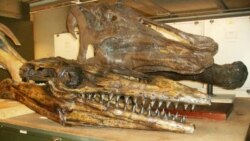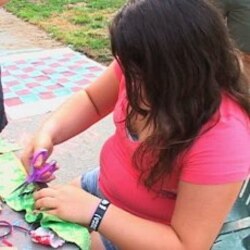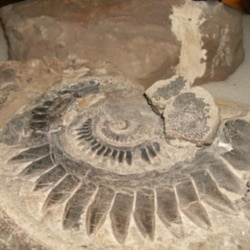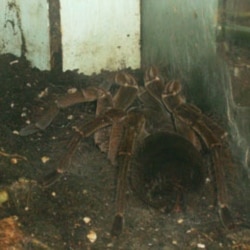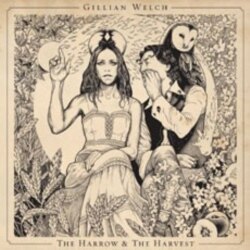DOUG JOHNSON: Welcome to AMERICAN MOSAIC in VOA Special English.
(MUSIC)
I'm Doug Johnson. This week on our show, we play new music from Gillian Welch… and we answer a question about a popular place to visit in Washington, DC…
But, first, we go to a place in Maryland where children get “artsy” every Tuesday.
(MUSIC)
Porch Art
DOUG JOHNSON: Every week, children gather at a home in the Remington neighborhood of Baltimore, Maryland. The house belongs to Beth Barbush, an artist and local community activist. The children will spend about ninety minutes there doing art projects under her guidance. The weekly “Porch Art” meeting is one of the largest and longest running art programs in this historic but sometimes dangerous area. Christopher Cruise has our story.
(NATURAL SOUND)
CHRISTOPHER CRUISE: Beth Barbush started “Porch Art” four years ago. She gathered a few art supplies from her home and several neighborhood children who had little to do in the summer. And she provided her own high energy.
BETH BARBUSH: “I started by doing it one night a week, an hour and a half a week, just hanging out with kids and it really benefited me because I got know the people here and I think it benefited them because it gave them something to do.”
The meetings soon moved from Barbush’s porch to the public sidewalk a few meters away. The boys and girls explore a new art form every week. This day, the project is print calligraphy but the children are also drawing, painting and sculpting. Middle school student Toha Mohamed enjoys the program.
TOHA MOHAMED: “Every week we do something cool and interesting that I wanted to do. Like arts and craft; we get to put things together, glue stuff.”
Other artists and local volunteers help teach the children at “Porch Art.” Many parents also take part. Mother Catherine Bear says the program is about community building and trust.
CATHERINE BEAR: “My child gets to do things, do something one day out of the week, like she don’t do any other day and she gets to spend time with other kids and do art.”
(NATURAL SOUND – GUITAR MUSIC)
The “Porch Art” event on this day is also the start of a music series. Local musicians volunteer to play instruments while the children do their art. Volunteer Jason Reed says the program makes a difference in the neighborhood.
JASON REED: “Having a bunch of houses crammed together, really close, doesn’t make a community and it’s things like this that do. I am not going to say that it reduces crime or it saves lives but none of these people would steal from each other, none of these people would hurt each other, so there is a sense of caring and responsibility and I don’t think that can’t be underestimated.”
Donors provide the art supplies. Sometimes volunteers provide them. No major groups provide money for the program. And Beth Barbush suggests that outside financial support is not necessary.
BETH BARBUSH: “Anyone can do this. You can do it with whatever skills you have. If you want to do it with music, cooking if you want to do it with theater or art or gardening. I just feel like it’s an example for others to be able to see that they can start a program like this.”
The artist says “Porch Art” has changed her life. This is the first time she has known all her neighbors by name and the only time she has truly felt part of a community.
Museum of Natural History
DOUG JOHNSON: Our question this week comes from Kogi state in Nigeria. Abubakar Yakubu asks about the Smithsonian Institution’s Natural History Museum in Washington.
Let us go there now.
(NATURAL SOUND)
This is the central room on the first floor of the Natural History Museum. The first thing you see when you enter is a huge African elephant. The animal was fifty years old and weighed eight tons when it was shot and killed in nineteen fifty-five. The hunter then donated the remains to the Smithsonian. Workers used its bones and skin to rebuild the elephant. Now it is a symbol of the Natural History Museum.
Around this big circular room are doors leading to the extensive collections in the building. There is a dinosaur room, a mammal room, a gems and mineral room, an ocean room and others. It would take days to really see everything here. But as museum press officer Kelly Carnes explains there is more than meets the eye. The museum is a living, breathing research center.
KELLY CARNES: “We have more than a hundred and twenty-six million objects. Less than one percent of those are on display at any given time. One of the interesting things about the museum that people don’t always know right away is that in addition to having objects on display out in the exhibits, we also have researchers actively doing science behind the scenes. So when you’re looking at exhibits, behind those big displays, are labs, offices, collections, where people are answering questions about our natural world and the science of our universe.”
Sometimes the scientists are also seen. Visitors to the dinosaur room can see a working laboratory. Behind the glass, fossil preparer David Lopez, is hard at work. A small electronic machine in his hand is working the surface of a fossil. A crowd has gathered to watch.
DAVID LOPEZ: “OK, I’m working on a rock that contains fossil bones of a small dinosaur called syntarsus. It’s looking like it’s part of the neck area of the animal and I’m exposing some of the bones from the vertebrae. They’re very, very small; very narrow.”
Researchers believe this syntarsus lived about seventy million years ago. It is a shock to look at that little animal and then enter the room where a huge diplodocus stands. This creature is many meters long and tall. It lived about one hundred fifty million years ago. The diplodocus has been part of the Smithsonian’s collection for more than a century. It has stood in the same place since the museum opened in nineteen-ten.
Kelly Carnes says about one hundred PhD level scientists work at the museum. There are also many other researchers and volunteers. And there are many other Natural History Museum scientists collecting information around the world. We wonder if there are any like Indiana Jones, the fearless archaeologist of movie fame.
KELLY CARNES: “One of our favorites is in our anthropology department Doctor Jane Walsh studies South American archaeology including crystal skulls that became very popular when the last Indiana Jones film came out which was about crystal skulls. A lot of the media that we spoke with at the time informally dubbed her Indiana Jane.”
Ms. Carnes says the Natural History Museum is working hard to reach more people more of the time. She says the expansion of resources through the Internet is a continuing project.
KELLY CARNES: “We get six million visitors a year here at the museum but we realize a lot of people can’t physically come to Washington, D.C. and come to the museum. So we love to make a lot of resources on line so people can visit them from wherever they are.”
One is the Ocean Portal, where people can find out about the ocean and its life.
KELLY CARNES: “One of the unique things about the Ocean Portal is that it’s actually a cooperative between several different organizations. So we get support from like-minded organizations like NOAA or National Geographic that are also sharing their information with us and allowing us all to be one source of information together about ocean science on our planet.”
The millions of people who do come to Washington and visit the museum, in reality, all seem glad for it. Like Xavier Nunez, a sixth grader from New Jersey. We talked to him as he left the dinosaur collection.
XAVIER NUNEZ: “I saw a tyrannosaurus and triceratops. And I also saw a lot of ancient fossils from the seas. I thought it was very interesting to see where they came from and how they went extinct and also how they moved around and looked.”
Gillian Welch “The Harrow and the Harvest”
DOUG JOHNSON: Singer and songwriter Gillian Welch is known for her striking and often dark songs. They sound like they came from a time long ago. Traditional American folk and bluegrass music have strongly influenced her work. Recently, Gillian Welch and her partner, guitarist David Rawlings, released a new album. Katherine Cole plays us three songs from “The Harrow and the Harvest.”
(MUSIC)
KATHERINE COLE: That was the song “Scarlet Town” from Gillian Welch’s new album “The Harrow and the Harvest.” It has been eight years since a collection of her songs was released. She and David Rawlings have said they wrote songs during these years, but doing so was not easy. They say there was little connecting the songs to anything else to form a record.
The two kept busy performing with other musicians, including Bright Eyes, Nora Jones and The Decemberists. They also recorded an album and performed under a new name, “The Dave Rawlings Machine.”
Here is the song “The Way It Will Be.” Their voices combine so well it is hard to tell where one voice ends and the other begins.
(MUSIC)
Gillian Welch and David Rawlings are performing their new music at shows in the United States this month and next. We leave you with “Six White Horses.”
(MUSIC)
DOUG JOHNSON: I’m Doug Johnson. Our program was written by Ana Ward, Dana Demange and Caty Weaver, who was also our producer. Join us again next week for music and more on AMERICAN MOSAIC in VOA Special English.



